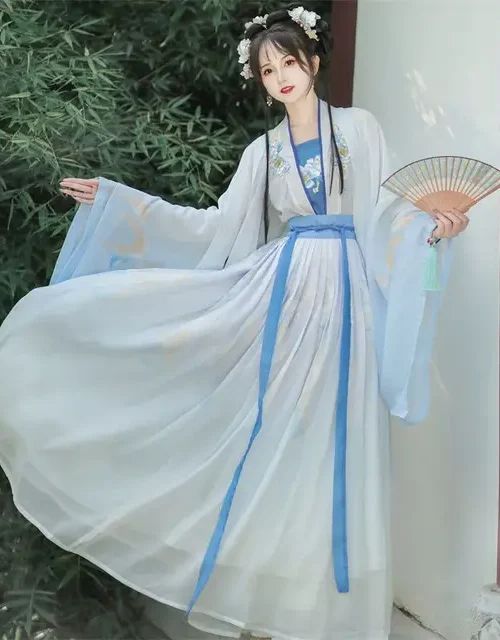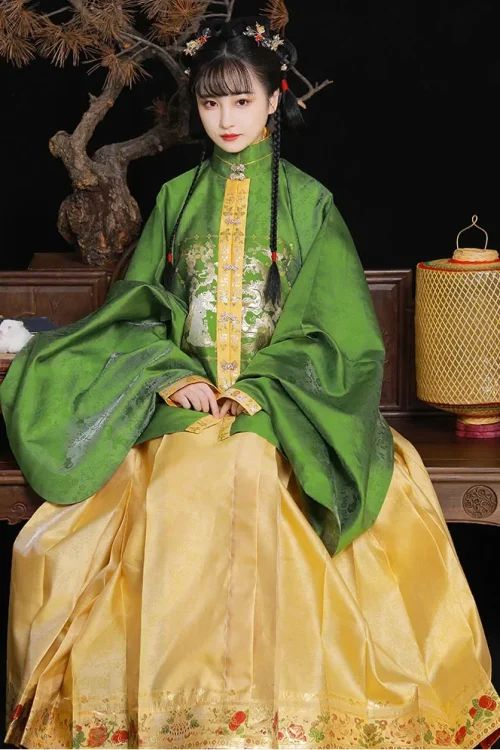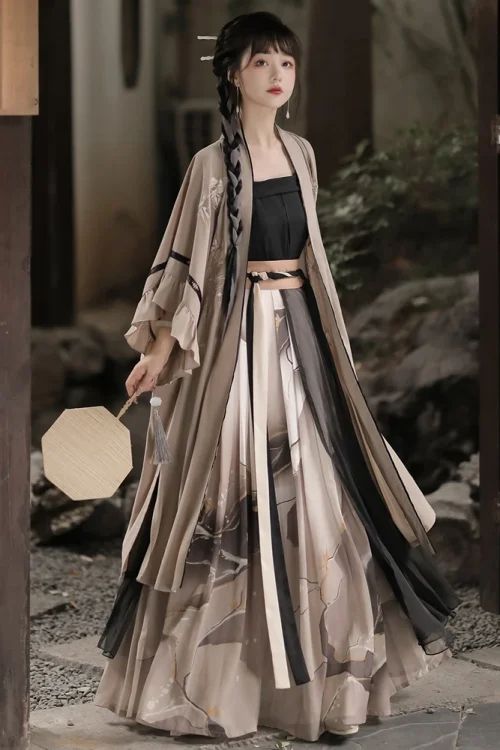A evolução do Hanfu: Ming Dynasty vs. Song Dynasty
Prominent Eras in Chinese History
The Ming and Song dynasties, two prominent eras in Chinese history, left an indelible mark on the evolution of Hanfu, the traditional Chinese attire. While both dynasties shared certain Hanfu characteristics, distinct differences emerged, reflecting the cultural and societal shifts of their respective times.

Elegance of the Song Dynasty
During the Song dynasty, Hanfu reached its zenith of elegance and refinement. The garments were characterized by their flowing lines, soft colors, and intricate embroidery. Women’s Hanfu featured long, wide sleeves that cascaded gracefully, while men’s Hanfu had more tailored silhouettes with narrower sleeves. The use of silk and other luxurious fabrics added to the opulence of Song dynasty Hanfu.
Practicality of the Ming Dynasty
In contrast, Ming dynasty Hanfu exhibited a more austere and practical style. The vestuário were shorter and less voluminous, with a focus on functionality and comfort. Women’s Hanfu featured a higher waistline and a more fitted bodice, while men’s Hanfu had wider sleeves and a more relaxed fit. The use of cotton and linen became more prevalent, reflecting the Ming dynasty’s emphasis on practicality.
Differences in Color
Another significant difference between Ming and Song dynasty Hanfu was the use of color. Song dynasty Hanfu favored soft, muted colors such as white, pink, and blue, which complemented the delicate embroidery and flowing fabrics. Ming dynasty Hanfu, on the other hand, incorporated brighter and bolder colors, such as red, yellow, and green, which reflected the more vibrant and energetic spirit of the era.
Social and Cultural Reflections
The evolution of Hanfu from the Song to the Ming dynasty was not merely a change in aesthetics but also a reflection of the changing social and cultural norms. The Song dynasty’s emphasis on elegance and refinement was a product of its prosperous and cosmopolitan society, while the Ming dynasty’s more practical and functional Hanfu mirrored its focus on stability and order.
Enduring Influence
Despite their differences, Ming and Song dynasty Hanfu both played a vital role in shaping the history of Chinese fashion. Their unique styles and characteristics continue to inspire contemporary designers and fashion enthusiasts, showcasing the enduring legacy of Hanfu as a symbol of Chinese cultural heritage.
Comparing the Styles and Silhouettes of Ming and Song Dynasty Hanfu
Distinct Styles
Ming Dynasty Hanfu and Song Dynasty Hanfu, two distinct styles of traditional Chinese attire, embody the cultural and aesthetic sensibilities of their respective eras. While both share the common thread of Hanfu, they exhibit unique characteristics that set them apart.

Characteristics of Dinastia Ming Hanfu
The Ming Dynasty (1368-1644) witnessed a revival of Hanfu after centuries of foreign influence. Ming Hanfu is characterized by its vibrant colors, intricate embroidery, and flowing silhouettes. The most iconic garment of this period is the “aoqun,” a long, loose robe worn over a skirt. The aoqun features wide sleeves, a high waistline, and a flared hem, creating an elegant and graceful appearance.

Simplicity of Song Dynasty Hanfu
In contrast, Song Dynasty Hanfu (960-1279) is known for its simplicity and refinement. The garments of this era are typically made from soft, muted fabrics such as silk and cotton. The silhouettes are more fitted and understated, emphasizing the natural curves of the body. The “ruqun,” a two-piece ensemble consisting of a long tunic and a skirt, is a common style of Song Hanfu. The tunic is often adorned with subtle embroidery or patterns, while the skirt is typically plain and flowing.
Sleeve Differences
One of the most striking differences between Ming and Song Hanfu lies in their sleeves. Ming Hanfu sleeves are wide and flowing, often extending past the wearer’s fingertips. They may be decorated with intricate embroidery or trim, adding a touch of opulence to the garment. Song Hanfu sleeves, on the other hand, are narrower and more fitted. They may be slightly flared at the cuffs, but they do not extend as far as Ming sleeves.
Accessories and Adornments
Another notable difference is in the use of accessories. Ming Hanfu is often accessorized with elaborate jewelry, such as necklaces, earrings, and hairpins. The garments themselves may also feature decorative elements such as tassels, ribbons, and buttons. Song Hanfu, on the other hand, is more restrained in its use of accessories. Jewelry is typically simple and understated, and the garments themselves are often adorned with subtle embroidery or patterns.
Conclusão
In conclusion, Ming Dynasty Hanfu and Song Dynasty Hanfu are two distinct and captivating styles of traditional Chinese attire. Ming Hanfu is characterized by its vibrant colors, flowing silhouettes, and intricate embroidery, while Song Hanfu is known for its simplicity, refinement, and fitted forms. Both styles reflect the cultural and aesthetic sensibilities of their respective eras, offering a glimpse into the rich history and diversity of Chinese fashion.
The Cultural Significance of Hanfu in the Ming and Song Dynasties
Periods of Brilliance
In the tapestry of Chinese history, the Ming and Song dynasties stand out as periods of cultural and artistic brilliance. Hanfu, the traditional attire of the Han Chinese, played a pivotal role in shaping the aesthetics and social norms of these eras. While both Ming and Song Hanfu shared common elements, they also exhibited distinct characteristics that reflected the unique spirit of their respective times.
Transformation in the Ming Dynasty
During the Ming dynasty (1368-1644), Hanfu underwent a significant transformation. The Ming court promoted a more conservative and formal style, characterized by long, flowing robes with wide sleeves. Men’s robes were typically adorned with intricate embroidery and auspicious symbols, while women’s robes featured delicate floral patterns and elegant accessories. The Ming Hanfu emphasized modesty and propriety, reflecting the Confucian values that permeated society.

Relaxed Fashion in the Song Dynasty
In contrast, the Song dynasty (960-1279) witnessed a more relaxed and cosmopolitan approach to Hanfu. The Song court encouraged a vibrant and diverse fashion scene, where people from all walks of life expressed their individuality through their clothing. Song Hanfu was often more colorful and less restrictive than its Ming counterpart. Women’s robes featured shorter skirts and more revealing necklines, while men’s robes were often paired with stylish hats and belts. The Song Hanfu embodied the spirit of innovation and cultural exchange that characterized the era.

Social Hierarchy Reflections
Beyond their aesthetic differences, Ming and Song Hanfu also held distinct cultural significance. In the Ming dynasty, Hanfu served as a symbol of social status and hierarchy. The elaborate robes worn by the emperor and his court distinguished them from the common people. Hanfu also played a role in religious ceremonies and rituals, where it was believed to connect the wearer to the divine.
Accessibility in the Song Dynasty
In the Song dynasty, Hanfu became more accessible to the general population. It was worn by scholars, merchants, and artisans alike, fostering a sense of cultural unity. Hanfu also became a medium for artistic expression, with poets and painters using it as a subject for their works. The Song Hanfu represented the cultural vibrancy and inclusiveness of the era.
Legacy of Hanfu
As the Ming and Song dynasties faded into history, Hanfu continued to evolve and adapt to changing times. However, the legacy of these two periods remains deeply embedded in Chinese culture. The Ming Hanfu’s emphasis on formality and tradition continues to inspire contemporary fashion designers, while the Song Hanfu’s spirit of innovation and diversity serves as a reminder of the rich cultural heritage of the Han Chinese people.
